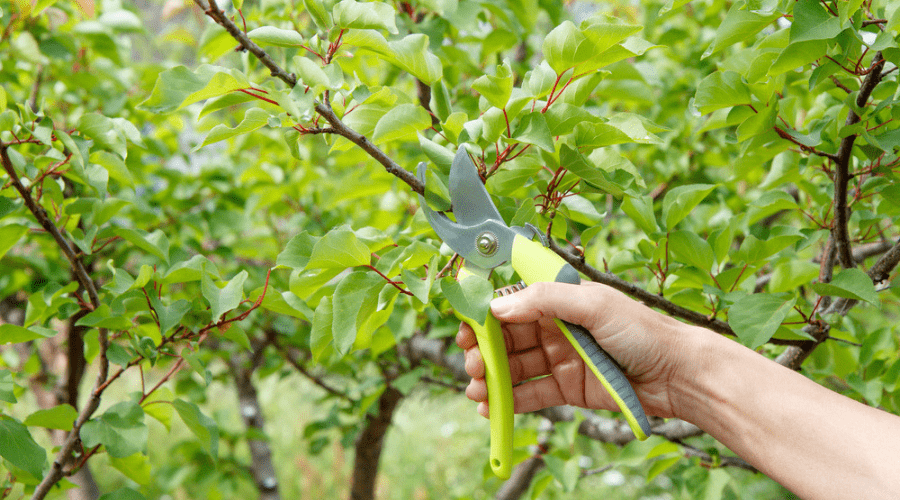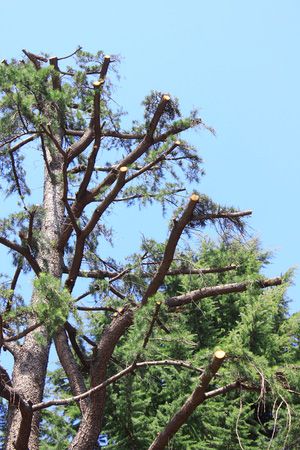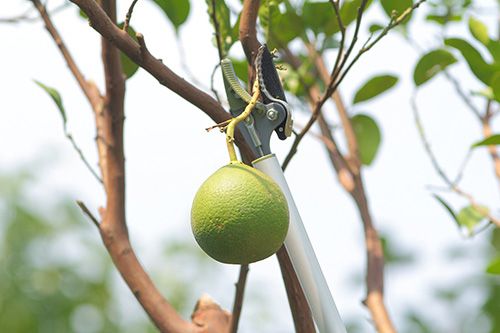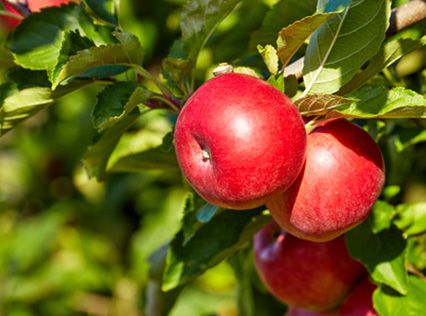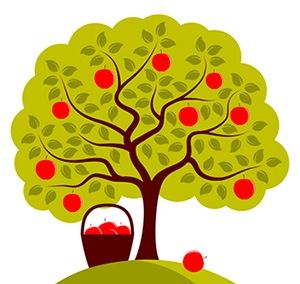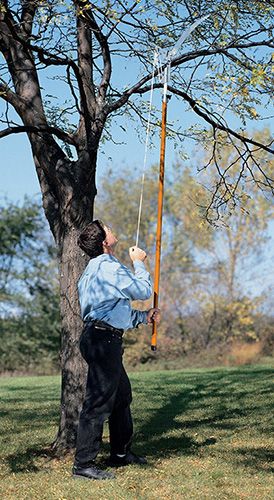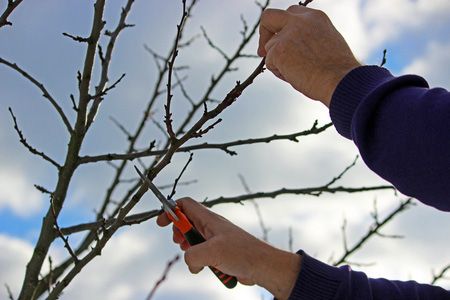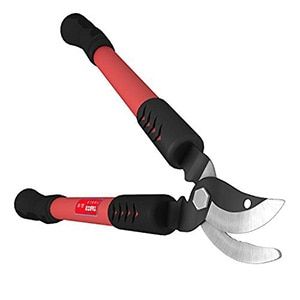When I became a new homeowner, I was pleasantly surprised to recognize a peach tree growing in my side yard. The poor thing was bedraggled with branches heading out every which way, and a bushy growth of suckers grew from its trunk.
Never having been a fruit tree owner before, all I knew at the time was that the suckers definitely had to go to the upper branches could get better nutrients. And so all I did was cut them off. The following spring the tree was loaded with flowers, and by late summer we had a decent little crop, but the fruit was centered on the inside of the tree and was difficult to reach.
There are many advantages of pruning fruit trees, as I discovered with a little research. Read on to apply much of what has been tried and true in my own garden!
*You might also like: How to Prune Producing Fruit Trees.
WHY PRUNE?
If you already own, or are thinking of planting a fruit tree, keep in mind that maintenance of your tree is essential not only for the overall health of the tree, but also for the quality of the fruit you will one day harvest.
STIMULATES GROWTH
Properly pruned and trimmed trees provide a strong network of healthy growth for fruit-bearing branches. This is important since it is only branches that are at a 45 degree or greater angles upwards that should be retained to support growing fruit, and more growth equals more branches to choose from to allow this.
Keeping sucker branches cut back also allows tree growth to focus towards the topmost branches of the tree, providing the essential nutrients needed for initial healthy growth each spring and through the summer. This new growth also results in new fruit-bearing areas.
CONTROLS SIZE OF TREE
Pruning helps train the size of the tree, and direct the growth where you want it to begin for early fruit production and optimum fruit quality conditions. Fruit trees benefit from early pruning starting at planting time in order to help balance out new root formation. Once good rooting has taken place, new lateral branches will be more in abundance to choose from to begin training healthy, strong branches in the overall shape you would like your tree to be in.
Trees that grow too high make it both difficult at harvest and for continual pruning practices. Branches that spread too wide will weaken the overall structure of the tree as well, especially when laden with ripened fruit.
IMPROVES QUALITY OF FRUIT
Proper pruning techniques allow for good light penetration into the tree, resulting in an increase in fruit bud production in subsequent years, and improves fruit quality of the current year’s crop.
Although pruning is technically a forced dwarfing process of the tree, and the overall yield of fruit may be slightly less due to a smaller tree size, the color, size, and quality of the remaining fruit will be noticeably improved.
WHEN TO PRUNE
Part of proper pruning techniques is knowing when, exactly, is the proper time to cut back your tree. Pruning during the wrong time of the season can result in damage or weakening of the existing branches.
SUMMER PRUNING
Summer pruning is used primarily to control the growth of young trees, provide light to existing fruits, thin crops, and remove undesirable wood, such as waterspouts and dead or diseased branches. This can take place on both tip-bearing and spur-bearing trees, but should always be taken on with caution to avoid damaging the wood that will produce the following year. Tip and spur-bearing branches differ in that tip-bearers form fruits along the tips of branches instead of the short spurs found along the branch. Spur-bearing trees are much more common, especially with popular fruits, such as apples and pears.
WHEN TO CONSIDER PRUNING
Ideally, summer pruning takes place when you want to help shape your tree, improve a current crop, or increase the next year’s harvest. Fruit matures better without being shaded by an abundance of foliage. Air and sunshine results in better growth for new branches, and larger and sweeter fruits, allows for easy fruit picking. It also helps keep pests and disease from taking hold.
COMMON TREES TO PRUNE IN SUMMER
Apples, pears, cherries and apricot trees are the most common trees to prune in the summer, although any variety can be pruned with the correct care. Cherries and apricots in particular can contract Eutypa Diebackeasily, a disease that kills off branches. When these trees are pruned during any sort of wet weather, even during dormancy, they are extremely susceptible to the disease- and many experts refuse to prune during dormant months because of this.
BENEFITS OF SUMMER PRUNING
Older, non-bearing branches are easier to see and remove in the summer to help open up the canopy for more vigorous, new branches. It is also easier to focus all new growth towards the outside and train your tree shape. Promoting stronger, wider crotches help with branch strength that split less easily, and it is much easier to help create symmetry in the overall tree structure for balance.
GOALS OF SUMMER PRUNING
As mentioned, summer pruning helps keep certain varieties of fruit trees from being threatened by specific diseases, but mostly it is used to encourage new summer growth from newly trimmed branches to produce fruit bearing buds the following year. This increases the yield on a properly trimmed trees and allows a propensity for a cycle of healthy crops year after year.
Summer pruning is also the main goal of keeping a tree’s size in check. Since a tree’s main goal is to keep a balance between the root system and canopy, you need to consider that heavy winter pruning will indicate to a tree coming out of dormancy to produce a lot of new growth from its stored up nutrients. Cutting back new growth during the summer that exceeds your size limitations will also help keep a healthy balance, and allow you to reach your crop!
WHAT TO AVOID
You want to be careful of how your tree produces fruit and know if it is tip-bearing or spur-bearing to avoid accidentally cutting growth that will produce new fruits. If you aren’t sure, you can look up it’s variety online, or take a branch cutting to a local extension agent for identification. Of course, trimming in summer doesn’t mean you are avoiding all forms of moisture, and care should be taken to avoid cutting when rain is in the forecast since diseases can spread during any season.
Fresh cut limbs during the growing season will produce sap and attract pests that will feed on fruit trees, and can carry disease and rot. Typically fresh cuts will easily seal themselves, but if it is particularly dry or too wet, this can interrupt this process- and it never hurts to provide your tree with a little help. To avoid this, seal your tree’s fresh wounds by applying a coat of liquid pruning sealer.
WINTER/EARLY SPRING PRUNING
Many fruit tree owners hold to pruning during the dormant seasons because the removal of current fruiting buds will invigorate existing buds on neighboring branches to produce larger, more healthy fruit come summer.
WHEN TO CONSIDER PRUNING
Once a tree has entered into dormancy and all leaves have fallen, you will be easily able to see the shape of the branches in order to best determine the shape you will want to prune to. You can trim at anytime during dormancy, and fresh cuts will easily dry and heal as new life comes to the branches in the spring, however, there are a few rules of thumb to consider.
Early winter pruning in areas of extreme cold can cause low temperature injury to the living tree tissue, and you may want to consider until late winter, or even early spring as it begins to warm. Be sure to trim in early spring before the tree comes out of full dormancy so as not to disrupt the new growth to too much an extreme.
COMMON TREES TO PRUNE IN WINTER
Any tree can be trimmed in the winter, but a good rule of thumb is to make sure that the air isn’t too moist, or that a winter rain or wet snowfall isn’t in the near forecast in order to let fresh cuts dry completely to avoid the spread of disease.
Fruit trees are classified as either pome (apples, pears, quince) or stone fruits (Peach, apricot, cherry, plums, etc…), and are most easily pruned in winter due to the lack of foliage. Between deciding to cut in summer, or cutting in winter- what it really comes down to is your personal preference for overall tree growth and shape – and ease of the task at hand. Personally, I like a little of both.
BENEFITS OF WINTER PRUNING
Besides promoting overall tree health as any good pruning job will do, winter pruning also reduces the overall surface areaof the tree and prevents an overload of snow and ice which can damage, and even break existing limbs.
Fire Blight and Stem Canker are two diseases which cannot spread well during the cold winter months, and can be kept in check by pruning during freezing, or near-freezing temperatures. Fire blight is a bacterial disease that attacks the new growth of apple trees, and left unchecked can kill a young, or weakened tree. Cankers are a type of fungi that takes root in open tree wounds and are incredibly destructive and difficult to manage.
GOALS OF WINTER PRUNING
The goals of winter pruning are to removed the 5 D’s(dead, damaged, diseased, defective, and decaying), to help shape the overall tree to your preference and increase the health of your tree. If you are unsure if a branch is dead or alive, simply scratch the surface with your fingernail to expose the cambium, living tissue that creates new cells, and check for green. If it’s green, it’s a living branch.
Thinning out areas of thick growth and crossing branches will also allow more air and light into the middle of the tree. Removing competing limbs helps create strong branch angles (between 45 and 60 degrees) as well.
WHAT TO AVOID
As with summer pruning, you’ll want to take care not to cut too many of the existing fruiting buds that will form fruits later in the summer. You’ll also want to try and avoid taking more than what’s absolutely necessary in order to help keep a healthy balance between the root system and crown. Over pruning can also be a very real problem, and it’s important to understand how to prune correctly in order to minimize mistakes that can threaten the life of the tree.
PRUNING YOUNG TREES
When first planting a new tree you will want to prune lightly immediately to help strengthen and expand the root system. Leave as much of the leaves intact as possible to uptake the nutrients needed to send to the roots, but remove any deformed or dead branches, and removing the leader branchis a common practice as well to allow more light into the canopy and force branches outwards.
Young trees should begin being pruned in earnest for shape, size, and productivity starting its first growing year. This is done by pruning to establish only three to five strong dominant shoots within the first two years of growth. Shortening of new growth should continue each season afterwards, and the removal of the 5 D’s (as mentioned above) should be applied as well.
Any fruit that forms within the first year should be removed. Some people like to remove any fruit within the second year as well in order to focus energy into healthy growth and root systems, however the first year usually suffices.
PRUNING OLD TREES
Avoid pruning older trees as much as possible since they are unable to come back from wounding as easily as young, maturing trees. Occasionally the question of topping, or cutting back older, tall branches to stimulate the growth of new wood is recommended- but this process generally results in an abundance of weak, thin branches, and opens up the tree to further susceptibility of disease and rot. It’s a practice that is best avoided.
Branch thinning is acceptable, and often needed from time to time, but care should be taken to undercut the branch to prevent bark stripping. This is when one partial cut is made between two full cuts to allow the branch to fall away under it’s own weight.
RESTORING NEGLECTED TREES
Old, neglected and gnarly trees are not uncommon around old farms, or homes where previous homeowners were unsure of how to care for their orchard trees. These trees are often difficult to maintain in that state, and many times they are cut down for simplicities sake. However, in many cases these trees can be brought back to a more manageable state.
Apple and pear trees are the most commonly restored trees, followed by cherries. Peaches and apricots cannot often be saved, and it is much easier to plant new trees than attempt to prune them back into shape. What you need to ask yourself is if the tree is worth saving. If it is, then check to see if the tree is structurally sound, free of compromising rots and disease, and capable of bearing heavy fruits.To prune your tree back into shape, begin by removing a third of the tree each season over a period of three years to reduce shock and stress, excessive new growth, and sunburn. Also, avoid fertilizers, especially nitrogen, as you want the root system to provide correctly for what cutting has been done.
Continue to follow proper pruning techniques once you have the tree managed into the shape and size you desire.
PRUNING SYSTEMS
There are multiple ways to approach pruning your fruit trees when they are young to establish the size and shape you desire as they mature and begin to produce yearly crops. Having a pruning system essentially creates an open canopy for accessible harvesting. Having an idea about your choices and how to go about completing them is nice to know before you make that first cut.
Central Leader System
This is a great way to train your fruit tree when you have very little space, but still want to include orchard trees in your landscaping. Espalier trees are trained to grow flat against a wall, or out in the open along a structure for branch support without taking up too much space. This is created by keeping the central leader cut to force outward branch growth after initial shaping takes place. 18 inches of space are needed between horizontal growth.
Using this technique you can also create a microclimate up against a wall and grow fruits that might otherwise be out of your growing zone. Typically you will want a three branch tiered at a maximum height at about 6 feet when complete after about three to five years of growth. After this time you will prune annually for maintenance.
Modified Leader System
Similar to a central leader system, the modified leader uses multiple vertical branches (typically three to five) rather than just one. The results being that you have a more upright, bushier version of a pyramid, tending towards a vertical oval shape. Spreaders are also often used with this as well to space branches evenly.
The most common trees pruned to this shape are apple, pear, plum, and pecan.
Open Center System
An open center system creates a vase shape by removing the central leader early in growth and only allowing evenly spaced scaffold branches to grow out horizontally at an approximate 60 degree angle. This technique allows for easy access, good central sunlight, and very little maintenance for branch thinning.
The most common trees pruned to this technique are peaches, apricots, nectarines, and plums.
Espalier
This is a great way to train your fruit tree when you have very little space, but still want to include orchard trees in your landscaping. Espalier trees are trained to grow flat against a wall, or out in the open along a structure for branch support without taking up too much space. This is created by keeping the central leader cut to force outward branch growth after initial shaping takes place. 18 inches of space are needed between horizontal growth.
Using this technique you can also create a microclimate up against a wall and grow fruits that might otherwise be out of your growing zone. Typically you will want a three branch tiered at a maximum height at about 6 feet when complete after about three to five years of growth. After this time you will prune annually for maintenance.
BASIC PRUNING TIPS
Keep in mind that pruning is the removal or reduction of plant parts that are no longer required for the health or production of the tree. It creates a force of additional energy to where it is most wanted, and needed on the tree. It functions to train, maintain, improve, and restrict growth.Plan your cuts in advance to remove the 5 D’s, and continue the shape you desire. Often winter pruning is favored because you can more easily see your tree’s structure and can easily remove what is not needed since it is not hidden by foliage.
Pruning can be done at any time of year, and keep in mind a good root to canopy ratio.
There are many types of tool available for pruning. Be sure to choose one that is sharp and easy to use to avoid damaging the branches. Hand shears and loppers are the most popular for gardeners to use. Choose one that fits your needs.
HAND SHEARS
LOPPERS
PITFALLS TO AVOID
- Be sure to make pruning cuts correctly as well to avoid further damage to the tree. You want to be sure of clean, angled cuts, and avoid the tearing or stripping of the bark which will create a wound that can both stress and draw insects and disease.
- Be sure to avoid over pruning your tree during its first year which can cause stress, or even death. The key to successful pruning to is to keep in mind that you can always take off more later if needed.
- Taking off too much in subsequent years can also force further weakened growth, or take away the ‘food’ (light and nutrients from the foliage) to the roots, resulting in a weakened crop the following year.
- Cutting too early in winter during cold spells can also cause further winter die-off damage, so be sure to prune after the worst of the winter is over in Northern climates.
CONCLUSION
If you own fruit trees, then don’t forget to maintain them! Not only is it not difficult, but the little effort it takes results in healthy trees, and a much better crop of fruits each year. Depending on your preference, you have a good variety of ways to train your trees, and don’t give up on those old orchards either! With a few years of careful pruning, you can get them producing like much younger trees again with just a little patience.
What was your favorite part of the article, or what would you like to know more about? Please comment and question below, and as always, please share!

